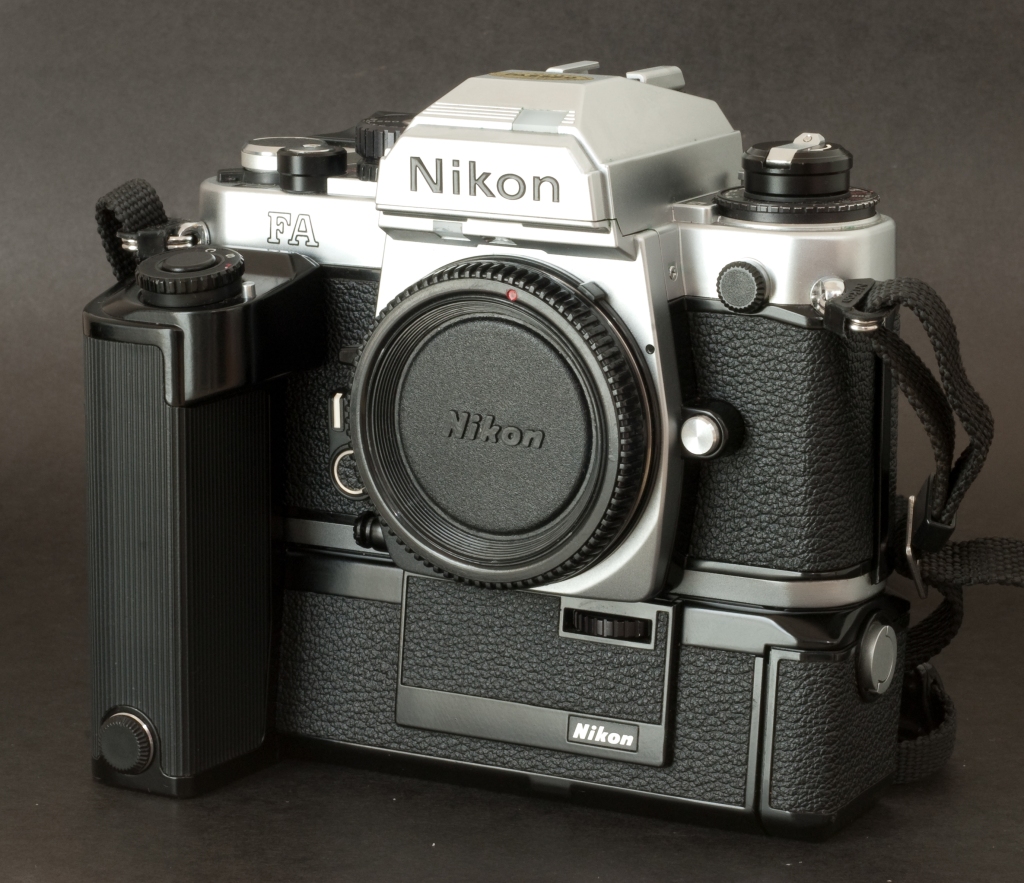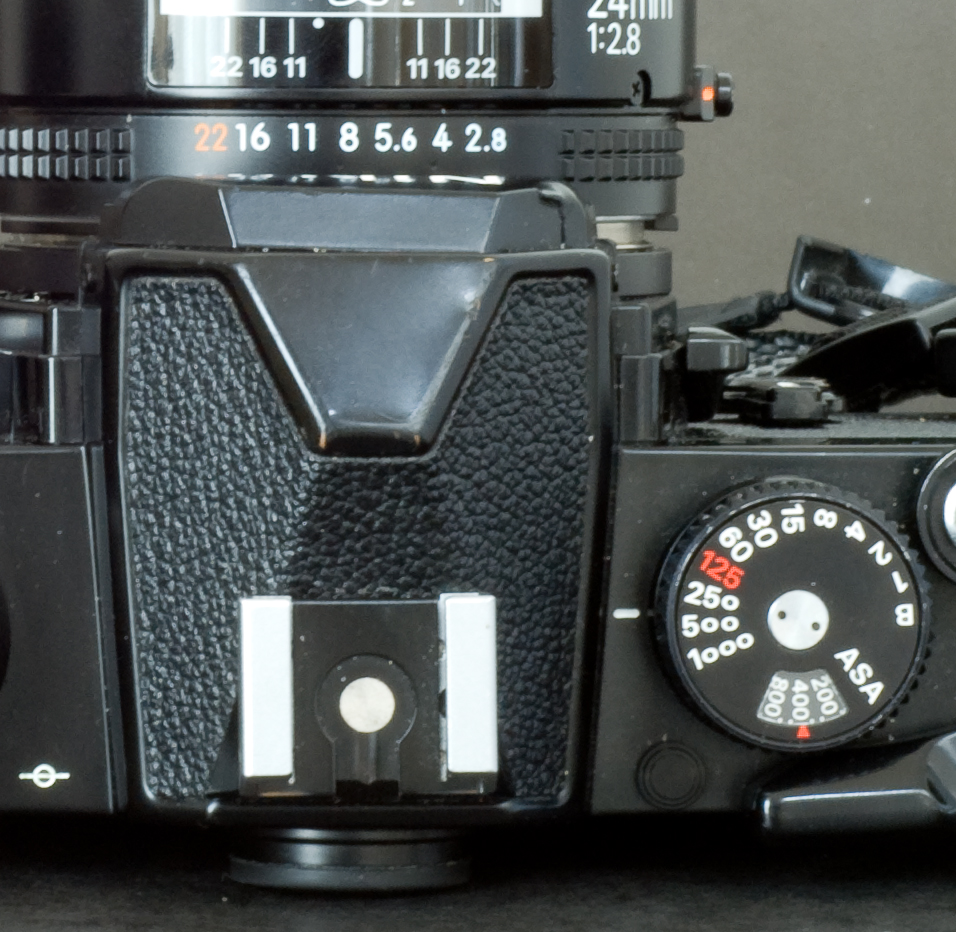The Nikon FA is the last major manual focus SLR launched by Nikon. An evolution of the FM2 and FE2 cameras, it shares with the latter most of its body shell, a very fast shutter (up to 1/4000sec., 1/250sec. flash sync speed) and a on the film (OTF) flash metering mechanism. It finally catches up with Canon’s A1 and offers the same four automatic exposure modes (aperture and shutter priority, program and semi-auto).
Its “Automatic Multipoint Metering” (AMP) – a world premiere – is its real claim to fame. Better known under names such as “matrix”, “evaluative” or “multi-segmented” metering, it is now the default metering system of every dSLR in production.
Launched in 1983, this conservatively styled camera with very conventional ergonomics had a relatively short sales career. It was made obsolete in 1985 when Minolta took the market by storm with its first autofocus SLR, the 7000 (Maxxum 7000 in the US). Minolta’s competitors, Nikon included, spent the best part of the following three years trying to catch up. The FA stayed on Nikon’s catalog until 1988, and was not replaced. Its semi-automatic sibling, the FM2n would be sold until 2001, when the FM3a, a sort of combination of the best characteristics of the FM2 and the FE2, was launched.

The metering system
Until the FA was launched, most of the cameras only offered some form of center weighted metering: the exposure sensor evaluated the luminosity of the whole scene, and because the sky is typically in the upper third of the frame, and the main subject of the picture in the center, it was designed to give more importance to the portion of the picture located at the center of the lower part of the frame.
It worked for most of the cases. If the subject was back-lit and not centered, the photographer had to determine the exposure with the subject at the center of the frame, memorize the exposure settings, and move the camera to compose the desired picture.
Some high end cameras also had a second exposure metering system, which evaluated the luminosity of a much narrower portion of the scene, almost a spot in the middle of the viewfinder. But spot metering and exposure memorization are not always easy to use, and are far from being idiot proof. The engineers at Nikon were pretty sure that with the newly unleashed power of integrated circuits, they could develop a new approach.
It was introduced with the FA, as the Automatic Multi Pattern (AMP) exposure system. The camera was equipped with a database containing the mathematical description of thousands of real world pictures taken by Nikon technicians, with the exposure value that had given the best results in each situation. The light meter was divided in five zones (a large central zone, two zones at the bottom left and right, two zones at the top, left and right also), and the electronic circuit would correlate the exposure value of each zone with other elements such as the focal length of the lens to define the characteristics of the scene, and associate it with one of the many typical pictures described in the database of the camera.

The Nikon engineers were so sure of the superiority of their AMP that they did not even equip the FA with an exposure memorization button – which so far had been a standard feature on high end automatic cameras. They just installed a little unmarked on-off switch on the right side of the lens mount housing, that conservative photographers could use to set the camera in the conventional “average center weighted metering” of yesteryear.
More about Matrix Metering and the alternatives developed by other manufacturers in this article of CamerAgX.
The ergonomics
The beauty of most manual SLRs resides in part in the simplicity of their commands. Each knob, switch, lever has only one function. If you turn the aperture ring on a semi-auto camera, the pre-selected aperture will change. Similarly, if you turn the shutter speed knob , the selected shutter speed will change.
The introduction of a automatic exposure did not really change the ergonomics. On a camera with aperture priority automatic exposure, you just had to select the “A” position of the shutter speed knob to let the camera determine the shutter speed automatically, and similarly on a camera with shutter speed priority, positioning the aperture ring on “A” indicated that you were willing to let the automatism manage the aperture for you.
Developing simple ergonomics became more difficult with cameras that could alternatively operate in semi-auto, aperture priority, shutter priority and program auto exposure modes. Most manufacturers added a big four way switch on the top panel, which could be set in Program, Shutter, Aperture or Manual. But when the PSAM switch was set on P or A, the shutter value did not match what was shown on the shutter speed knob, as shown in the example below.


On the Nikon implementation, the photographer also had to remember to set the aperture ring to the smallest aperture, and the indications in the viewfinder (a very small LCD display showing alternatively the speed or the aperture selected) did not really help.
The ergonomics of modern “all-electric” cameras are totally different. The aperture ring and the speed knob are gone, leaving room to an “electronic input dial” and to a large LCD. Not as intuitive and immediate as the knobs and rings or yesteryear, but far simpler than the complex combinations of knobs and switches of the Nikon FA.
Using a Nikon FA as an everyday camera
When it was launched, the FA was nicknamed the “techno-camera”. Positioned at the top of the FM-FE family of cameras, it came with an impressive specs sheet: matrix metering, multi-mode exposure automatism, very fast shutter, on-the-film (OTF) flash metering. Its detachable motor drive was reasonably fast (3.2 frames per second) and could power the camera (and save the precious LR44 batteries).
With the exception of the prism housing (in poly-carbonate), the camera is still built in metal, and is very nicely finished. If the complex electronics from the early eighties survived, the FA is still perfectly usable, and will take great pictures.
Should you buy a Nikon FA? That’s a matter of taste. More recent cameras (film or digital) provide the same technical features, but with their large LCDs and their electronic dials, they’re easier to use and less conducive to set up errors than the FA. The AMP metering of the FA is still relatively primitive – it did not reach the level of performance of today’s matrix metering, and it deprives the photographer of his control over the exposure. Switching to the center weighted mode does not really offer more control, unless the semi-auto exposure mode is used, because no exposure memorization mechanism has been provided.
The Nikon FE2 or the FM3a share some of the technical advances of the FA (the titanium shutter and the flash metering in particular), but their simpler ergonomics (match needle in the viewfinder, shutter speed knob and aperture ring always showing the actual settings) as well as their more predictable exposure metering make them a better fit for photographers who want to be in immediate control of the basic settings of the camera.
The value of the camera on the used market reflects this. In spite of its impressive list of specs, the FA sells for approximately the same price as the Nikon FE2 ($125 to $200 on eBay depending on the condition of the camera), below the FM2n (approx. $250) and far below the FM3a ($500 and above).

The hand grip (on the left) has to be removed to leave room for the MD-15 motor. As a consequence, this tiny accessory has often been lost and most surviving FAs don’t have it.
More about the Nikon FA
The Usual Suspects…
Nikon’s own words: Imaging Products-Nikon Family- Nikon FA and FE2
Photography in Malaysia (MIR) The Nikon FA
Ken Rockwell: The Nikon FA
